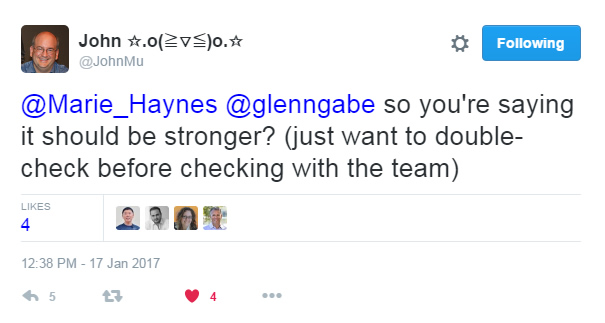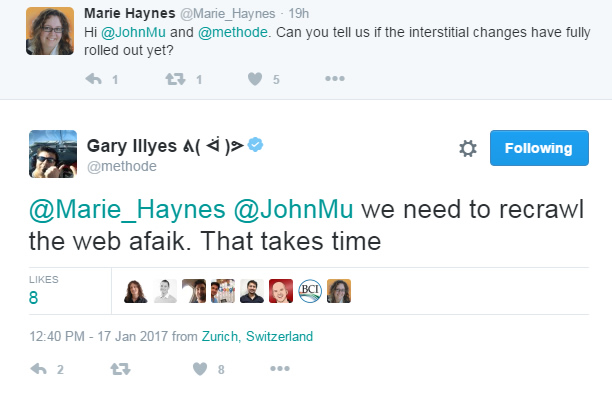Update 2/8/17: We are now a full month into the rollout of the mobile popup algorithm and I am still not seeing widespread impact. I did surface a few examples of urls being impact during the first week of the rollout, but there are still many sites employing mobile popups or interstitials that have not been impacted at all. I am tracking close to seventy different websites using mobile popups and interstitials, and almost all of the urls I’m tracking rank exactly where they did prior to the rollout. I will keep tracking the situation and post updates and more examples as I surface them.

When it comes to Google algorithm updates, it’s not often we know about those updates before they roll out. Typically they roll out and we react, analyze the impact, and then try to determine what’s going on. But that’s not always the case. There are times where Google provides fair warning that an update is coming, so webmasters can make the necessary changes in order to avoid negative impact. That’s exactly what we are experiencing right now.
In August of 2016, Google announced that sites employing mobile popups or interstitials on pages that users visit directly from the Google mobile search results “may not rank as highly”. The date Google provided was January 10, 2017 (this week). So webmasters had about five months to figure out a plan.
Would those webmasters cave in to Google’s pressure and remove mobile popups and interstitials, or would they stand their ground and keep them? For many sites, those popups drive conversion (email signups, sale notifications, event ads, social follows, etc.) But for many users, those popups and interstitials were extremely disruptive. From young users to old, those popups caused a lot of grief.
Monitoring The Rollout
In preparation for the mobile popup algorithm, I began compiling a list of sites that employ mobile popups or interstitials. My plan was to check mobile rankings as the algorithm update rolled out on 1/10/17 to gauge the impact. On Tuesday, we received confirmation from Google that it was indeed rolling out, so I fired up my tools and started checking mobile rankings. I initially didn’t see any changes at all, but that makes sense based on comments from Google. For example, John Mueller said that it could take a few days to see impact since the algorithm had to fully roll out.
So here we are… a few days out from the rollout and I’ve been heavily checking my data. Below, I’ll provide the first examples of the mobile popup algorithm in action (from WhoSampled.com, which uses a mobile interstitial asking users to download their mobile app). As you’ll see below, the urls dropped by over 10 spots (from page one to two).
——————————-
{Update 1/12/17: I just added screenshots from pcmag.com, which also provides a mobile popup when visiting from Google search}.
{Update 1/14/17: Although I have found several examples of the mobile popup algorithm in action, I have not seen widespread impact. I am tracking over fifty different websites that employ mobile popups and many of their urls rank exactly where they did before the algorithm rolled out. I will keep monitoring the situation and will post updates as I surface more findings.}
{Update 1/16/17: We are now seven days into the rollout of the mobile popup algorithm and I am still not seeing widespread impact. Yes, I have seen some examples, which you can see listed below, but there are still many sites employing mobile popups or interstitials that have not been impacted. I am now tracking close to sixty different sites that use mobile popups. I will post more examples of impact as time goes on (if there are any). Stay tuned.}
{Update 1/18/17: We are now nine days into the rollout of the mobile popup algorithm and I am still not seeing widespread impact. Again, I am tracking close to sixty different websites using mobile popups and almost all of the urls I’m tracking rank exactly where they did prior to the rollout. I reached out to Google yesterday on Twitter and John Mueller said he would pass along feedback to the team handling the mobile popup algorithm (about the lack of impact I’m seeing across sites). Also, in response to Marie Haynes, Gary Illyes tweeted that Google might need to recrawl urls prior to any impact being seen. Gary said, “We need to recrawl the web afaik. That takes time.” I don’t know if that’s the case, but it’s worth noting. Both tweets are displayed below. I will keep tracking the situation and post updates and more examples as I surface them.}
Google’s John Mueller on Twitter regarding the strength of the mobile popup algorithm:

Google’s Gary Illyes about possibly needing a fresh crawl:

{Update 1/20/17: We are now eleven days into the rollout of the mobile popup algorithm and I am still not seeing widespread impact. Actually, I’m not seeing much movement at all. I just ran through my list of sites using mobile popups or interstitials (~60), and almost all of the urls I checked rank exactly where they did prior to the algorithm rolling out. And the mobile rankings match the desktop rankings (meaning the urls are not being demoted in the mobile search results. I have not heard anything back from Google regarding the rollout based on the tweets listed above. I will try and post another update soon.}
{Update 1/24/17: We are now fifteen days into the rollout of the mobile popup algorithm and I am still not seeing widespread impact. I am checking twice per day based on a long list of sites still employing mobile popups or interstitials. I truly hope we are not seeing the final mobile popup algorithm. If this is it, I fear publishers that have removed popups will revert back to using them. And then publishers that stood their ground and kept mobile popups or interstitials will continue to employ them. That would be unfortunate… Time will tell. Stay tuned.}
{Update 2/8/17: We are now a full month into the rollout of the mobile popup algorithm and I am still not seeing widespread impact. I just checked my list of close to seventy domains using mobile popups and interstitials and I did not see any changes. If this is it, then the mobile popup algorithm is officially a dud. I will post another update if I see any changes. Stay tuned.}
——————————-
I’ll keep checking urls from across sites and update this post with more examples as I surface them.
Examples of the mobile popup algorithm in action:
1. WhoSampled.com
Query: wanna be a baller
Previous Rank: 6
New Rank: 20
Screenshot of ranking on 1/12/17 (#20)

Screenshot of ranking on 1/8/17 (#6):

2. WhoSampled.com
Query: 6 foot 7 foot
Previous Rank: 5
New Rank: 16
Screenshot of ranking on 1/12/17 (#16):

Screenshot of ranking on 1/8/17 (#5):

3. pcmag.com
Query: hotschedules
Previous Rank: 3
New Rank: 13
Screenshot of ranking on 1/12/17 (#13):

Screenshot of ranking on 1/08/17 (#3):

Summary – The Algorithm Rolls Out, Webmasters Adjust
It should be interesting to see how websites adjust based on the impact. I know that some wanted to test the waters to see how bad the impact could be, and then refine based on the severity. The algorithm is on a url-by-url basis, so changes to specific urls can be made quickly. I’ll be monitoring the situation closely and will update this post, if needed.
GG

I am watching a client with a homepage that requires users to register when arriving from Google via mobile and their brand term…. so not an interstitial or pop up, but I would argue the same thing.
If I search for a brand, I want the website…. first click free still a thing?
If a user types the domain in they are also taken to exactly the same registration page so not a different experience on mobile, but on desktop you do not get the register page, but are taken to the homepage.
That’s an interesting situation. So users are presented a form and can’t visit the page? If so, I would think that would get hit by this update. If you can share the url privately (via email), then I’d love to take a look.
What about popunder ads? It will affect ranking? I have popunder on touch for mobile version. Please some one tell me.
Great question. I don’t believe popunders would be impacted by this update, but I’ll double check with Google. It’s more about making sure the user experience isn’t inhibited by a popup or interstitial (when users visit from the mobile search results).
That said, I would b every careful with popunders, since most users have no idea that’s going on. That can definitely lead to frustrated users (and we know how Google is always looking for user happiness). It can also fit under the “deception” umbrella, which is obviously not good. I hope that helps.
Hello Glenn,
Thank you for your reply, I will be waiting to hear further from you about popunders and how it affect on ranking.
It will be interesting to see what the impact is on international sites firing geo-ip pop-ups offering country/language/currency options. From a UX POV this is a great way to help users get to the “local” site based on their location (IP).
However, John Mueller has suggested that these popups should be replaced by onpage banners but I still haven’t seen any evidence that sites with this set-up have been impacted.
Do any of the sites monitor have this set-up? It will be interesting to hear if you’ve noticed anything interesting.
Glenn, you say pop-ups convert and I know that the benign ones like newsletter sign-ups do for sure. (I’m not sure that’s so unfortunate, by the way. If people truly hate them, they wouldn’t sign up.) But I wonder how well some of the others you describe truly do convert. Do pop-up ads really get click-throughs? Click-throughs that don’t bounce right back? How long do people view auto-play videos? I’m guessing those more invasive ones really don’t do much good.
But here’s my problem with Google’s decision. As I say, I don’t think people hate the overlays as much as they say. When we help clients with them, we don’t just measure conversion rate for it, but also how it affects the Bounce rate. The effect is almost always negligible. People just don’t get that annoyed and leave (presumably because these are less intrusive). They do a simple click and it’s gone. They may say they hate them, but it doesn’t change their behavior.
So Google already takes quick bounces into consideration. So a site that has a really annoying interstitial would see more frequent occurrences of people bouncing, and their ranking should be hurt anyway.
What if people said they don’t like sites with black backgrounds? Would Google decide to penalize those sites for their design strategies?
Thanks for the updates Glenn! However I was wondering, does the size of the pop-ups matter? Will Google still penalize little side pop-ups?
The popup would need to cover a substantial amount of content. Think about a user coming to your page via Search and then having a popup cover a lot of the visible content. That’s what would be targeted. But… I’m still not seeing widespread impact from the mobile popup algo. I hope that helps.
Hi Glenn! Thanks for the response. Good to hear it doesn’t affect that much. Although, I think this penalty was quite a helpful one for us users.
Google is only looking at the visit from mobile Search, so the setup you explained is fine (as long as users arriving from Google don’t see the popup). But, users don’t like popups so I would try and figure out another way to alert them on mobile (like a banner or some other callout – without blocking a majority of the content). But again, Google is only looking at the first hop from Search.
Note, I’m still not seeing impact from the algo… I will check my data again, but it still seems extremely weak (if it’s doing anything at all). Just an fyi. :) I hope that helps.